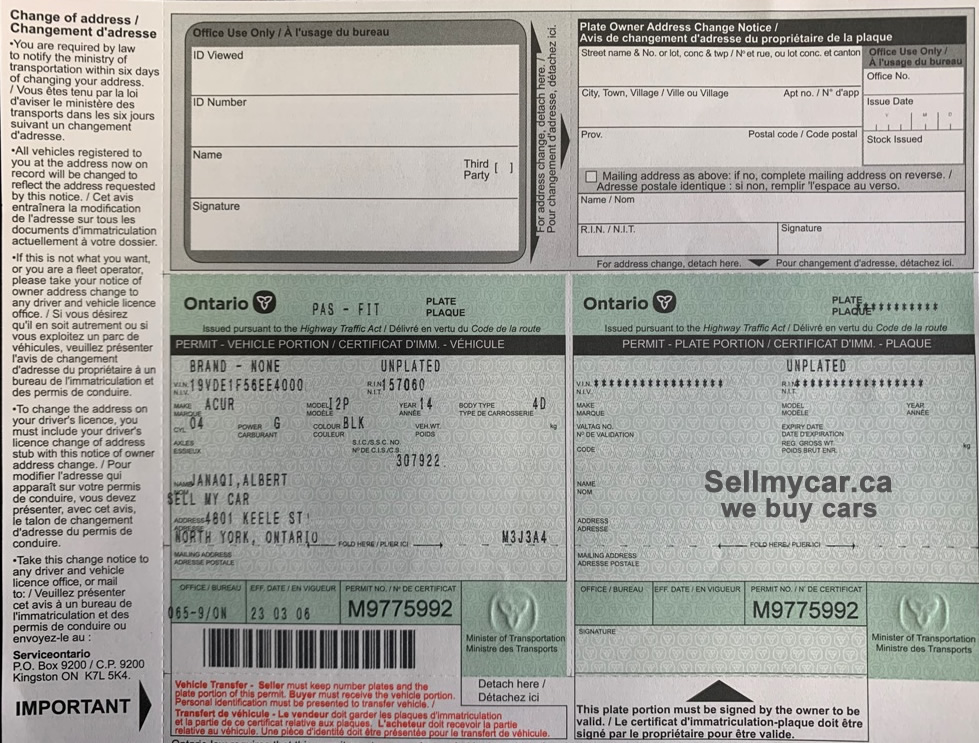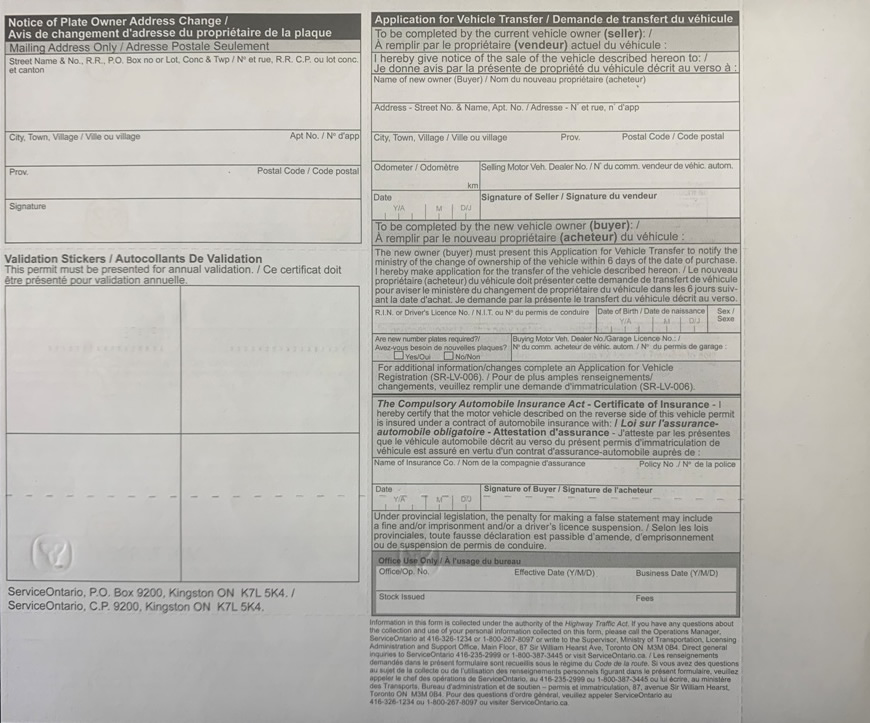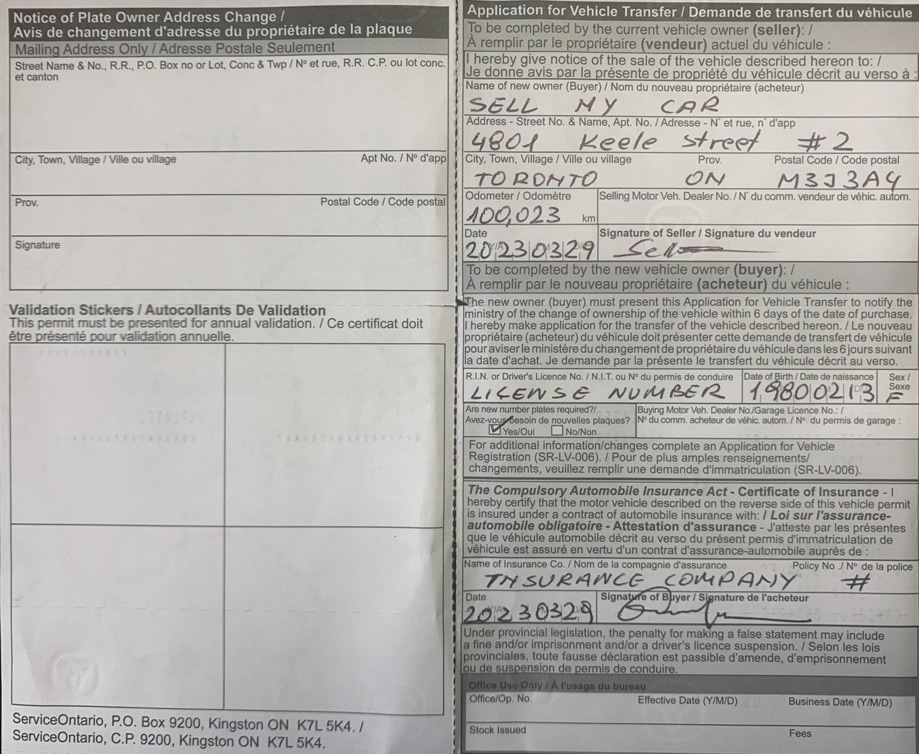Ontario Vehicle Ownership: What It Is And How To Use It
Ontario Vehicle Ownership, car ownership, or the green paper is an important document for many car owners living in Ontario. Whether you are buying a new car or selling your old one, it is important to understand the laws and regulations about vehicle ownership in the province. Here, we will try to shed some light on an overview of car ownership in Ontario and guide you through the process of transferring ownership of a vehicle if you buy or sell a used car.
What Does the Ontario Vehicle Ownership Looks Like?
This two-part document consists of a front and back section. The left portion, also known as the vehicle portion, contains important information about the vehicle, such as:

- Owner’s name
- Address
- Driver license number
- Vehicle Identification Number
- Vehicle make and model
- Year of production
- Number of cylinders
- Brand (rebuild/none)
- Fuel type
- Plate number
On the back of the vehicle permit, you’ll find the application for vehicle transfer, which is the document required when you sell the vehicle. This section must be completed by the seller before the car can be registered in the buyer’s name. The application for transfer includes information such as:

- Name of buyer
- Address of buyer
- Odometer reading
- Date of purchase
- Seller signature
- Buyers driver license number
- Name of insurance company
- Insurance company policy number
- Signature of buyer
The right portion of the vehicle ownership document, also known as the plate portion, contains information about the plates, including the driver’s license number, whether the plates are fit or unfit, and the plate number. It’s important to give the left portion of the vehicle ownership document to the buyer and keep the plate permit when selling a vehicle because the plates may be needed again for a new vehicle purchase.
When do I need a Vehicle Ownership in Ontario?
There are several situations where you may need a car ownership document, including;
- Selling or buying a car
- Being pulled over by the police
- Registering your vehicle in another province or country
- Getting insurance
- Scrapping a car
- Donating a car
- Transferring a car to a family member
How to Transfer Car Ownership in Ontario?
To transfer ownership of a vehicle, start by filling out the back of the ownership document with the seller’s information, date of purchase, and vehicle mileage, and giving it to the buyer. Both the seller and buyer will need to sign the application for vehicle transfer. The document will then need to be taken to Service Ontario to transfer the vehicle under the buyer’s name.

What Other Documents do I Need to Transfer Vehicle Ownership?
When transferring vehicle ownership in Ontario, there are several documents that buyers need to register their vehicle and get it plated with the Ministry of Transportation (MTO). These documents include:
- Application for transfer of ownership
- Used Vehicle Information Package (UVIP)
- Valid driver’s license
- Proof of insurance
- Bill of sale
- Safety Stardard Certificate
- Payment of the Harmonized Sales Tax (HST)
- Appraisal Form if Vehicle is Over 20 Years Old
How Much Does it Cost to Transfer Car Ownership?
The cost to transfer car ownership in Ontario is $32 at any ServiceOntario location, and the buyer is responsible for paying the HST of the vehicle unless otherwise stated in the bill of sale.
How to Replace a Car Ownership?
If you lose your vehicle ownership document, you can get a replacement from ServiceOntario by filling out a lost application form with vehicle and personal information. The cost for a replacement ownership is $32.
How Many Names Can be on the Car Ownership?
In Ontario, it’s possible for two drivers to own the same vehicle, whether they’re family or friends. However, it’s important to consult with your insurance provider regarding the cost of the policy for two drivers.
How to Transfer a Car Ownership After Death?
Whether you need to transfer a car ownership from an Estate after a loved one’s passing or are moving from another province, the process can be straightforward if you have the right documents and information.
If you’re the executor, you’ll need to provide ServiceOntario with the following documents to transfer the car ownership:
- A copy of the will
- Vehicle ownership papers
- Personal identification
- Proof of insurance
- Proof of death certificate
It’s advisable to consult with your lawyer to ensure all necessary steps are taken during this process.
How to Register a Car From Another Province in Ontario?
If you’re moving to Ontario from another province and own a car, you’ll need to transfer its ownership by:
- Visiting a ServiceOntario location
- Completing the required paperwork
- Providing your driver’s license and personal information
- Paying a 13% HST tax
Transferring Ownership of a Leased Vehicle
If you’re leasing a vehicle, you cannot transfer ownership as you’re not the actual owner. The dealership’s name will be on the ownership documentation, and the only way to transfer ownership is to buy back the vehicle and pay the HST.
Owning a car in Ontario has benefits and responsibilities, including the need to transfer ownership when buying or selling a vehicle. By following these guidelines, you can ensure a smooth process for transferring Car Ownership in Ontario.
